Viewpoint – Camera Perspectives
Choosing a perspective is truly an endeavour that must be analysed on a case-by-case basis. There is both an element of lining up the benefits of each techniques and intent of the team.

In this opinion-driven post, I'm going to discuss different camera perspectives in video games, their affordances, and why one might choose one over another. These are all personal opinion from a non-designer. Before we get there, however, I'd like to define some terms I'll be using. These are by no means standardised: they are simply useful terms to differentiate concepts in this piece.
First Person Perspective (FPP)
The type of camera where we see through the characters eyes.
True First Person Perspective (TFPP)
A subcategory of FP cameras where the body of the character is included in the perspective. Instead of have the camera move around the space and – generally – attach arms to it, TFP has a character with a body and attaches the camera to that. The skeleton of that character drives the camera position, and care does need taken to ensure fluidity of animation and prevent motion sickness.
Third Person Perspective (TPP)
The type of camera that orbits the player character.
Third Person Over Shoulder (TPOS)
A subcategory of TPP that draws the camera much closer to the player character. Third-person shooters are commonly found of this perspective.
Fixed Perspective
A fixed perspective is when the camera is fixed to a given plane. Side-scrollers or top-down camera's are a good example of these.
Isometric
This perspective that don't rotate and view the world in a "2.5D" view. The earlier Pokémon games are a great example of this type.
Perspectives
What are they good for?
First Person
Ah, the first person camera. We see through the eyes of the character we inhabit. In a sense, we become them, or something to that effect. As with all perspectives, the camera will only carry so much weight. The rest is on the narrative.
This type of first-person camera was more popular in older first-person shooter (FPS) games than in some of today's latest and greatest, and it's still got advantages in those settings. Namely, because the camera is the root of the player, their is an immediate response to control input without any extra work. There's no fighting animations to get what you want. No back-breaking oddities that appear in the Crysis franchise to get cover systems to work. And to be clear, that's not a dig at Crysis nor at Crytek, the tricks used to make true-first person work are part of the almost mystic complexity of modern games.
True First Person
In contrast with "normal" first-person perspectives, a true first-person perspective shows the entire body, and lets that body drive the camera. Control inputs affect the player characters animation, which in turn affects the camera position.
This layer of indirection does mean that there is more risk of input delay or erroneous or otherwise non-linear control responses. At the risk of sounding obvious, a note to programmers of this mode that care has to be taken to handle the input before the animation is updated for that frame; otherwise, you get one frame of delay. Ask me how I know...

That said, true first-person perspectives are immersive in terms of being that character. The above screenshot of Cyberpunk 2077 shows the true first-person perspective well. We inhabit V, and in this scene, we are sitting in a futuristic tank.
Affordances
Ever perspective has affordances. Our choice of which to use comes down to a case-by-case basis analysis of what serves our vision of the game the best. For first-person perspectives, I'm grouping the affordances together. Both types that I've listed afford very similar things.
Limited Visibility
The first-person view is more immediate than other views, in general. They are excellent perspectives to use when limited vision is warranted. Although first-person often uses higher field of view (FOV) settings than third-person, it is far more constrained in what it shows.
For example, first-person perspectives cannot see directly behind themselves without turning around. That is to say, you cannot see both forward and backwards at the same time. It is for this reason that the horror genre is so fond of the first-person perspective: first-person affords horror by way of it's limited vision.
Unity
Another thing a first-person perspective affords is becoming one with the character. Since you, the player, see from the characters perspective, you become them in a way. Your actions are their actions, and the things that affect the character, affect you. Or something to that effect.
It can be logically jarring in first-person to have the character incapacitated, only for the camera to become cinematic and continue to show the player the scene, since the "player" isn't actually conscious for this segment.
This combining of player and character also helps deny story information to the player – or just not divulge it – in a way that can be satisfying. Its opposite is also true.
Close-Quarters
While not the best example, the below image of Cyberpunk 2077 shows a corridor that appears quite roomy. Part of that is because it, well, is. At somewhere north of three metres wide, this corridor is more akin to bedroom in width than a hallway, but that aside, it's spacious because our perspective handles interiors quite well.
Think again of this corridor but in a more distant third-person perspective. There is a decent chance that our camera would collide with the walls if it wasn't aligned lengthwise down the corridor.
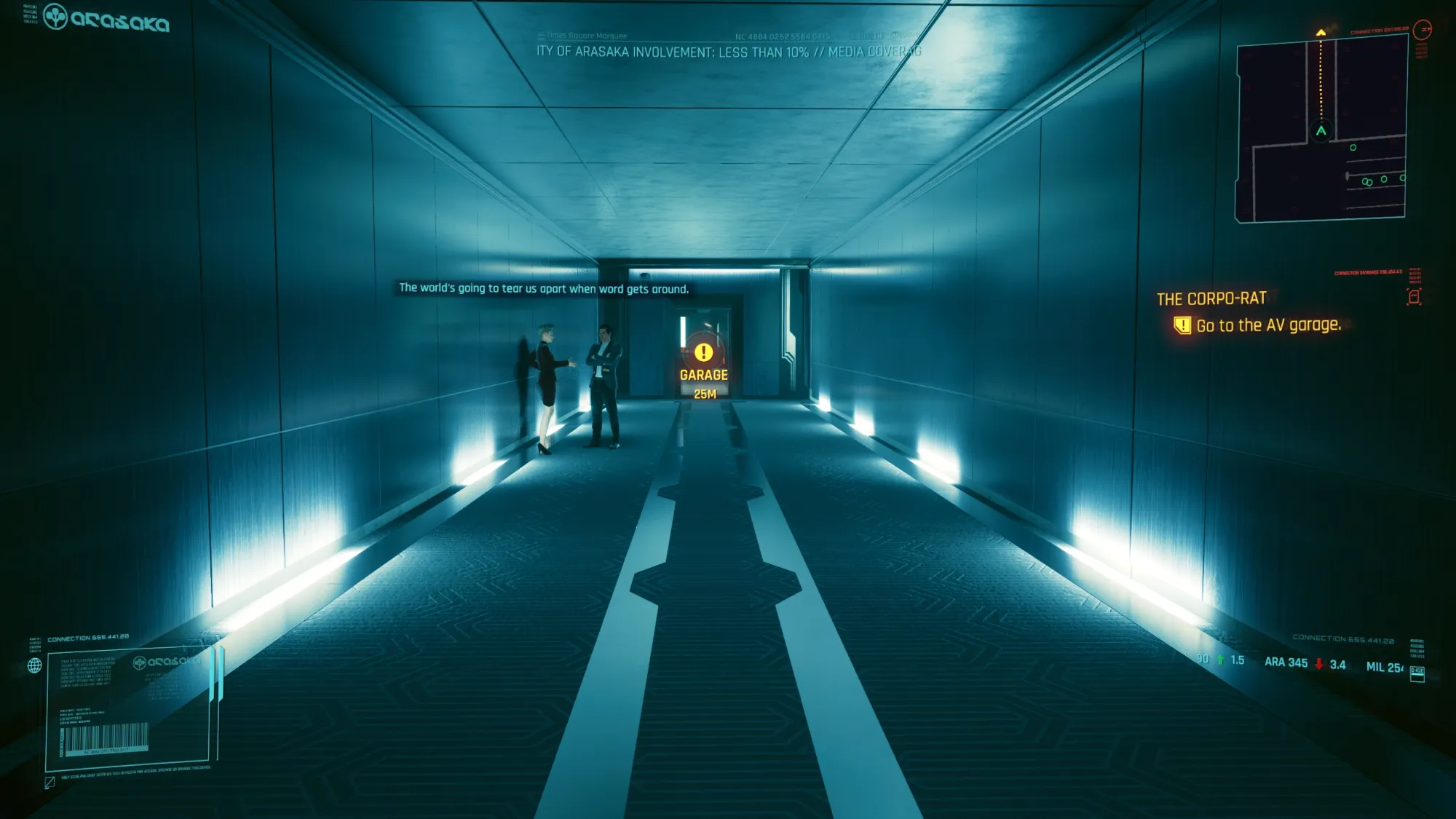
This handling of interiors is even better shown off by Prey 2's helicopter ride and Cyberpunk's AV ride in the introductory segments of those games.
In both cases, we sit in an enclosed space that is barely two metres wide, and yet it feels spacious enough. Yes, we can't move because the game doesn't want us to, but we're not left fighting with the camera to make sense of the environment.
Both games made use of this time to show us impressive scenes of the game's world, though notably, the city is not explorable in Prey 2. It instead serves to show an in-universe credits sequence.
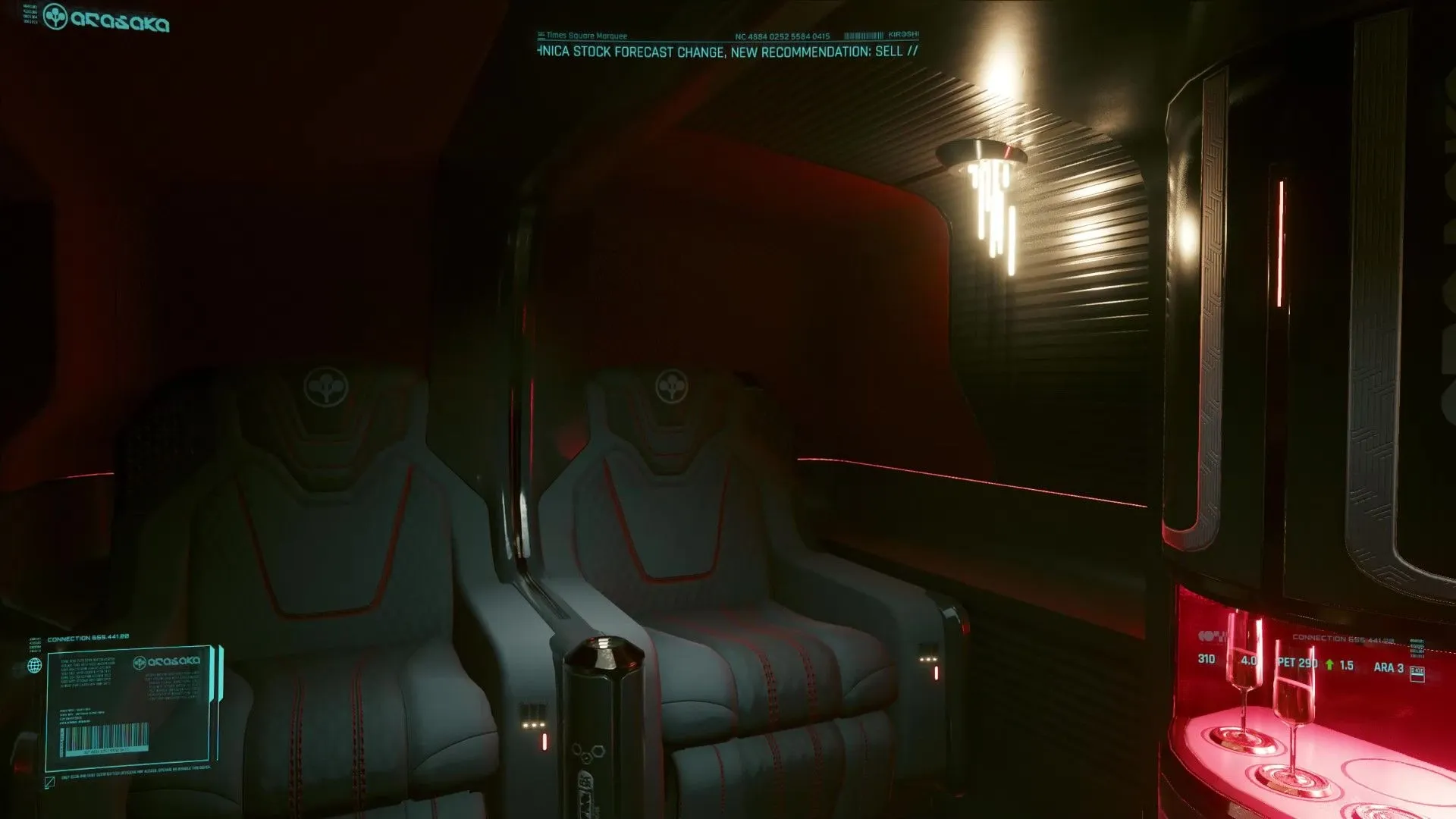
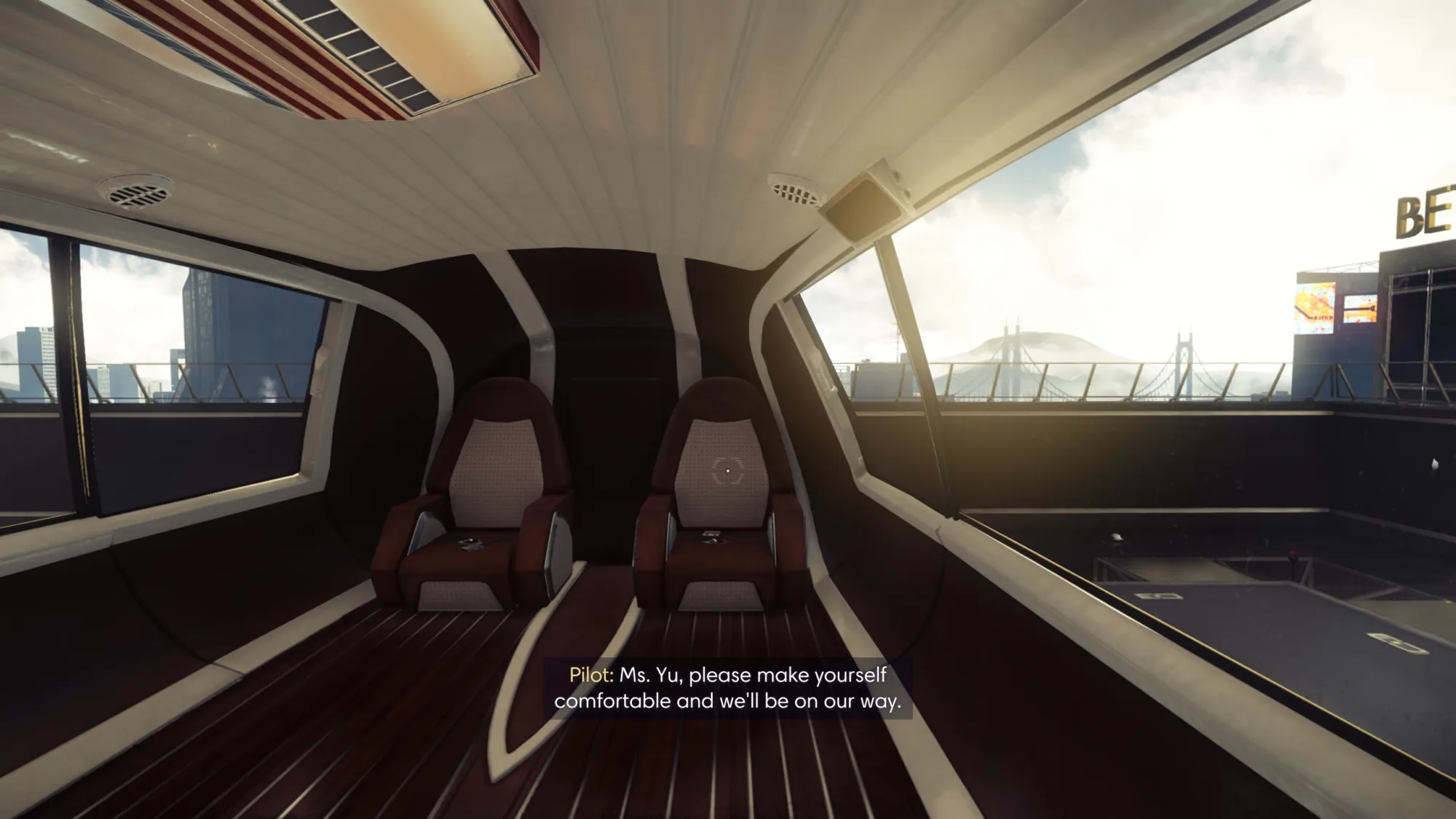
Left: Cyberpunk 2077 by CD Projekt Red, Right: Prey 2 by Arcane
Both of these interiors show a trend: first-person is also the only camera type that can handle these tight spaces. Microsoft Flight Simulator 2020 also uses a first-person perspective for the cockpit view. Partially because it's realistic, but also because the cockpit of an aircraft is an extremely close space. Notably, none of these examples allow movement within the space.
Non-affordances
Obviously, the opposite of any of the afforded attributes of perspective are likely not afforded by that same perspective, but there are some things that first-person simply does not lend itself to in either way.
Cinematography
A first-person camera does not lend itself to doing cinematic work. Yes, this perspective does allow for cutscenes, and some very immersive ones at that, but it tends to close the metaphorical door on types of camera shots common in film.
In part, I note this here as it leads into the cinematic perspective later. It should be noted that no gameplay camera can really do cinematics. The procedural nature of a camera driven by gameplay is not pre-authored and lacks authorial intent.
Third Person
The third-person perspective puts us in the shoes of a ephemeral observer of the character. In this perspective, we orbit the character. The perspective makes no distinction between movement modes. That is to say that this perspective does not prescribe how movement is handled by a game. The character may be locked to the camera direction where left and right controls lead to strafe actions, or the character may be able to run toward the camera.
Guild Wars 2 – below – allows the latter, which allows an even greater level of situational awareness.

Third Person Over Shoulder
A modification of the third-person perspective that pulls the camera in to have it riding on or near the character's shoulder.
The left image below shows Gears 5's over shoulder camera. Gears 5's camera is slightly higher on the character than in something like Hellblade by Ninja Theory, where the camera vertically centred closer to Senua's middle back. The image overstates this as it's looking downward, but it is a little higher when looking at the horizon.
The image on the right shows a slightly different perspective. This time, we see the camera looking toward the sky. Note that in this image, the camera is far closer to our character than the first. There's a lot more flexibility in third-person cameras in general, and this game appears to move the camera closer in some cases. In gameplay, the game uses the distance in the left image, but in certain areas, the right camera distance shows up. It is possible that the camera is actually intersecting with geometry behind it.

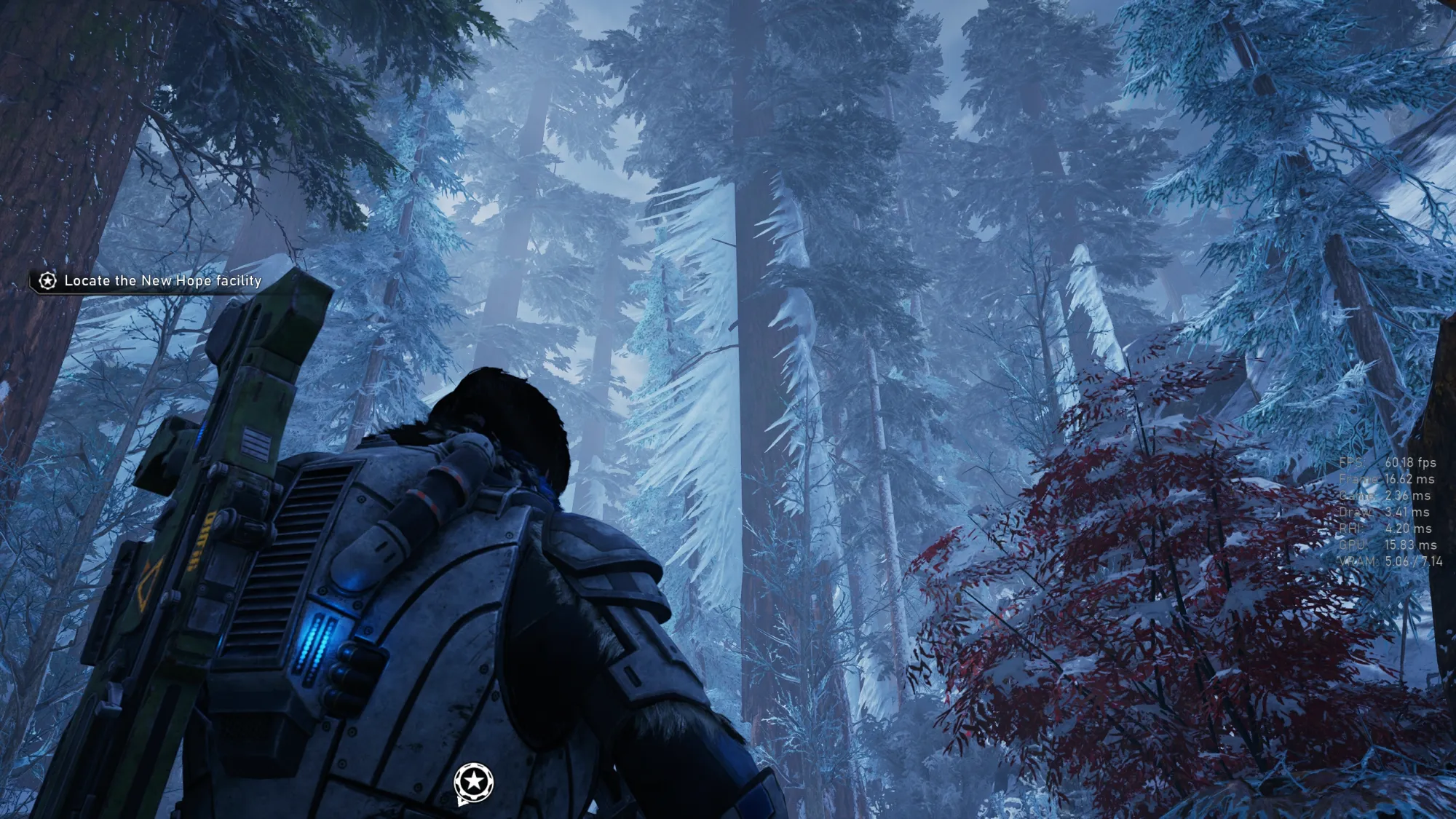
Gears 5 by The Coalition
Affordances
For third-person, I've split up affordances into separate subcategories. The ones from third-person will carry over to third-person over shoulder perspectives unless mentioned in that perspective's affordances.
Vision
Third-person perspectives can see a limited amount behind the player. As shown in the Guild Wars 2 screenshot, the camera can somewhat see directly behind the character. It's relatively easier to see why horror doesn't favour this type of camera: the visibility it provides of the environment and its ill-suited nature in enclosed spaces leads to stronger uses elsewhere.
What third-person perspective does allows, however, is spatial awareness. Because you can see the character at a distance, you can see the relation of the character to their surrounds. This awareness is most useful when player needs to know this relationship between character and environment, such as in some platformers or in games with dodging mechanics. Housemarque's Returnal and FromSoftware's many titles are good examples of the later.
It is true that some platformers to indeed use a first-person camera, such as Ghostrunner, but I'd argue that jumping need not be perfectly precise in that game, nor need it be in the two Mirror's Edge games or Dying Light 2. These games cheat for the player in subtle ways; otherwise, the game would risk feeling unfair.
Character
Unlike in first-person, we can see our character in full. Now, it is true that over -the-shoulder cameras can't always see the legs of the characters, I still count it. These camera modes are far more likely to show details on the player's character, and in contrast with true first-person, they show their back as well as their front. Notably, some over-the-shoulder cameras don't allow for the player to see the front of the character.
However, when I write "character", I also mean the personality of the character in question. I'll cover a bit more of this later in "Choosing a Perspective", but in short, we can see bits of the characters reaction to world events without resulting to cutscenes. By letting the animations of the character and their design speak for them, we can ascertain a sense of their character without them speaking. Whether this is used to great effect in most third-person games is certainly debatable, but when wielded with intention, it reveals a lot about the character and their mood.
Information
Unlike in first-person perspectives, and due to the ease of transition to cinematic perspectives, the third-person perspective allows you to tell the player things the character does not know. It's allows you – the developer – to speak to the audience directly and to hint, or outright tell, the player something that they can use to extrapolate the future. It enables the player to know that the character – or even better, their familiars – is currently walking straight into a terrible situation with no way to prevent it.
With all techniques, it's easy to get wrong. Tell the player the character will die when they go through that door and don't let them turn around, they'll probably feel railroaded. Use the same technique to show the player that one path has crazy loot and a hard boss while the other has an easier boss but less loot, and you've presented the player with the information needed to make a meaningful choice. The character is removed from the player at this point and isn't making the choice.
It's a touch-harder to replicate the same in first-person but by no means impossible. It just involves not "cheating" – because you can't – and actually showing the consequences for both choices to the character.
That said, this technique can be used to great effect, especially if you don't want the character to have full knowledge of something for narrative reasons, but by not showing the player, you risk them clocking out of the narrative.
Take the film – I know, I know, this is a game development blog – Vantage Point. This film makes use of the third-person camera to limit what we see but also to reveal more than any individual character actually saw. The film works by having a short, twelve to fifteen minute segment of an assassination play out through multiple peoples third-person perspectives. Over the course of the film, we slowly learn more about what happened and can piece more of the plot together, culminating in the final viewpoint of the assassin that reveals how it went down.
It's a great example of the third-person camera's ability to both reveal information and to hide it. We can choose – with far greater – control what we do and don't show. I should note that this works in the reverse too. We can leave the character for a moment when something happens to them that we'd rather not show. Maybe for budget or age-rating reasons, for effect, or to give the character their privacy. It's the cinematic equivalent of something being unspeakable.
Cinematic
Now, you could argue that this is a third-person perspective, or at most a subcategory of one, but I'd argue that how this camera is used is very different from a third-person perspective in a gameplay setting. This perspective could probably also be called "filmic", which may better represent its roots in film.
Namely, this is the camera we get in third-person cutscenes. Typically, these cameras are highly choreographed and their position and view are known ahead of time. This allows them to apply greater fidelity effects – such as better bloom in Unreal or higher quality shading – or higher fidelity assets – typically, a reserved LOD level – for the cutscene.
One of the key advantages of this perspective is the ability to use conventional cinematography techniques. We choose our shots – much like a director would – for emotion or storytelling effect.
I'm unsure if the introduction to Gears 5 – where the below frame is from – is actually rendered by the game or if it's a video, but the games cutscenes in the game are rendered in real-time, and the image shows a nice, filmic close-up shot.
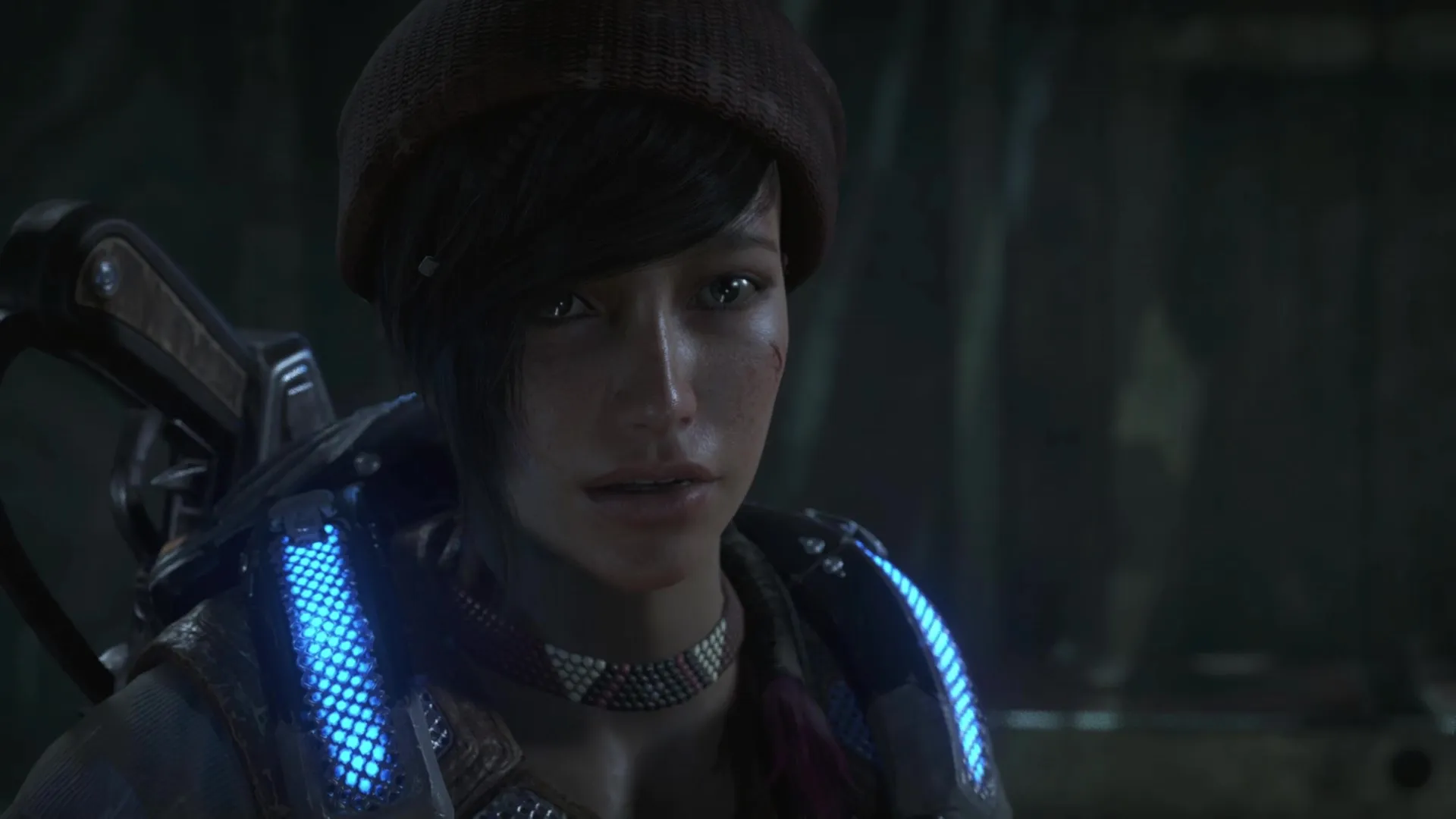
Some cinematics include increasing frame time budgets. In games that do allow this, the frame time often rises to a more "cinematic" 33.33ms – up from 16.66. This has the added benefit of allowing far greater fidelity not only for the aforementioned reason, but also because we have twice as long to spend on a frame. I'm not sure of that many games using that technique today. Halving the framerate tends to be noticeable, but it is an option.
Affordances
In short, the cinematic perspective enables cinematography techniques found in the film industry. From establishing shots to extreme close-ups, this perspective enables all of it. The flip side is that it affords exactly no procedural gameplay.
Fixed and Isometric
I've wrapped these together as my example – Octopath Traveller – is isometric, but the concept remains. One of the benefits of this view is that the content is only viewed from one angle. This constraint reduces the complexity of the assets that need created in the game, which isn't to say it's a way to cheap out: budget constraints are a very real part of game development and need careful management.
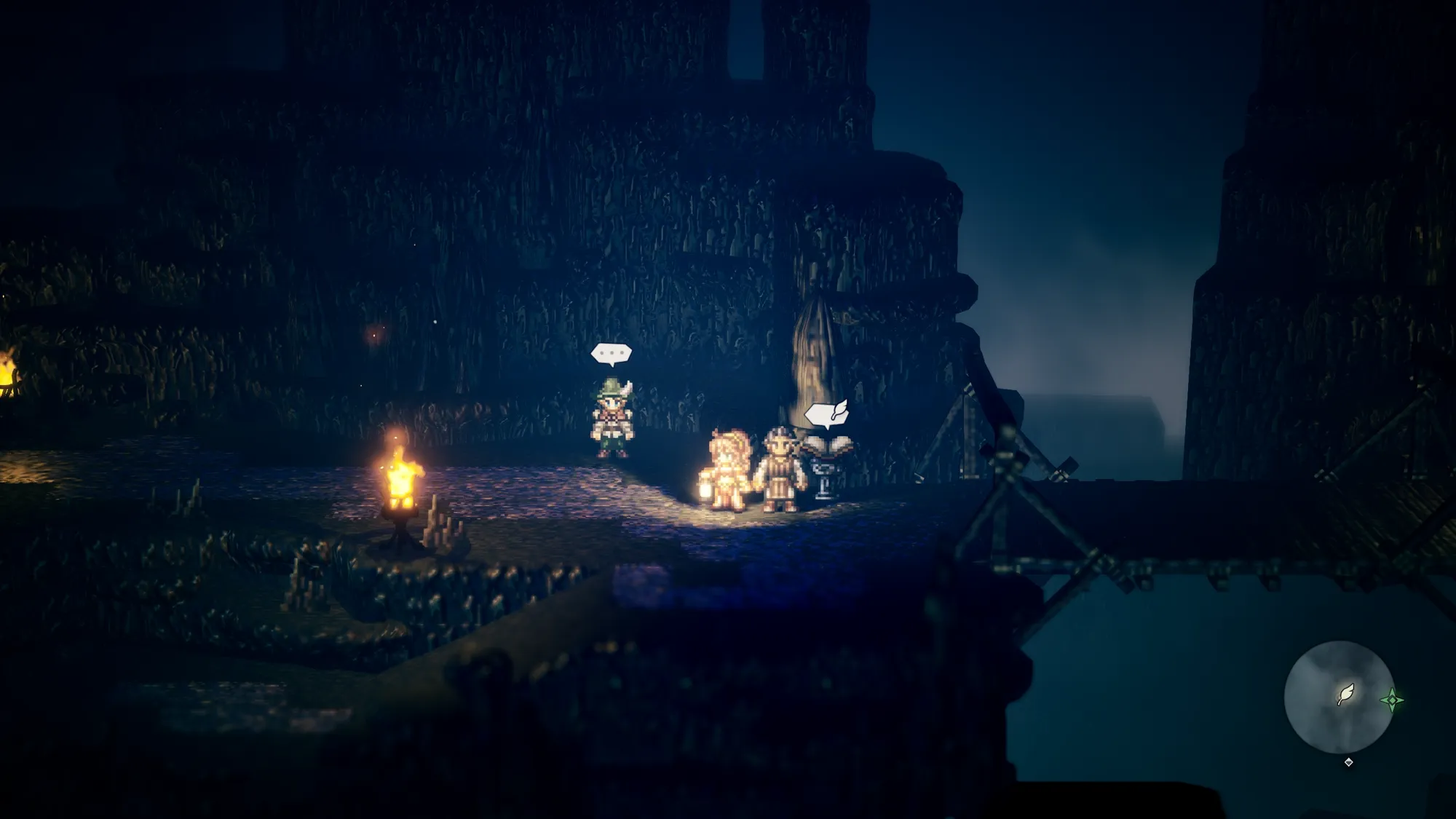
In terms of what the views do, Isometric places more of a emphasis on character or the vertical dimension while top-down offers more emphasis on the navigable plane. Octopath Traveller places a lot of weight on the story of each of the characters, so the isometric view is fitting.
Choosing a Perspective
Why not both?
Choosing a perspective is truly an endeavour that must be analysed on a case-by-case basis. There is both an element of lining up the affordances of the techniques and intent of the team.
I mentioned earlier that the third-person perspective allows us to gauge a characters character by their animation. This can be a key design decision for using the third-person family of perspectives as it affords this type of storytelling.
But what if you want close spaces, like the interior of a crashed spaceship, but you think the third-person camera fits the moment-to-moment gameplay better?
Housemarque's Returnal – and I'll apologise now for a lack of images of the title – does exactly this. The gameplay of Returnal benefits from the spatial awareness that a third-person gives, but the interior of the spaceship is too small for that perspective to handle with any amount of grace. For this reason, Returnal transitions from third-person to first-person when entering the spaceship Helios and the opposite in reverse.
Returnal is far from the only game that does this. Resident Evil 3's remake does it very early in the game, but unlike Returnal, it only does it once and remains third-person over-the-shoulder for the rest of the game.
Variable Cameras
While the transitioning from first- to third-person requires forethought, dynamically adjusting a third-person perspective is quite viable. The images below from IO Interactive's Hitman 3 show this off well.
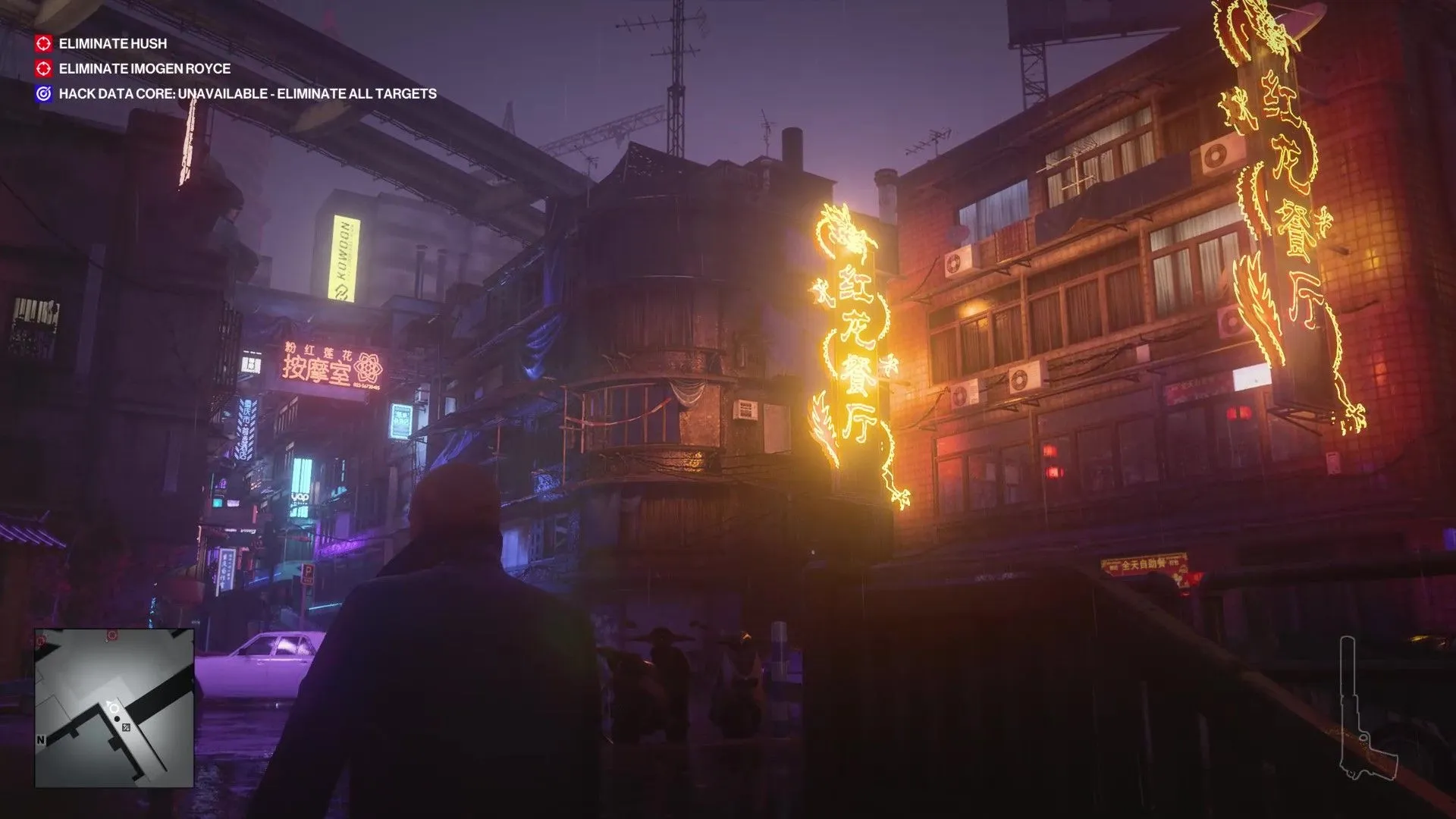
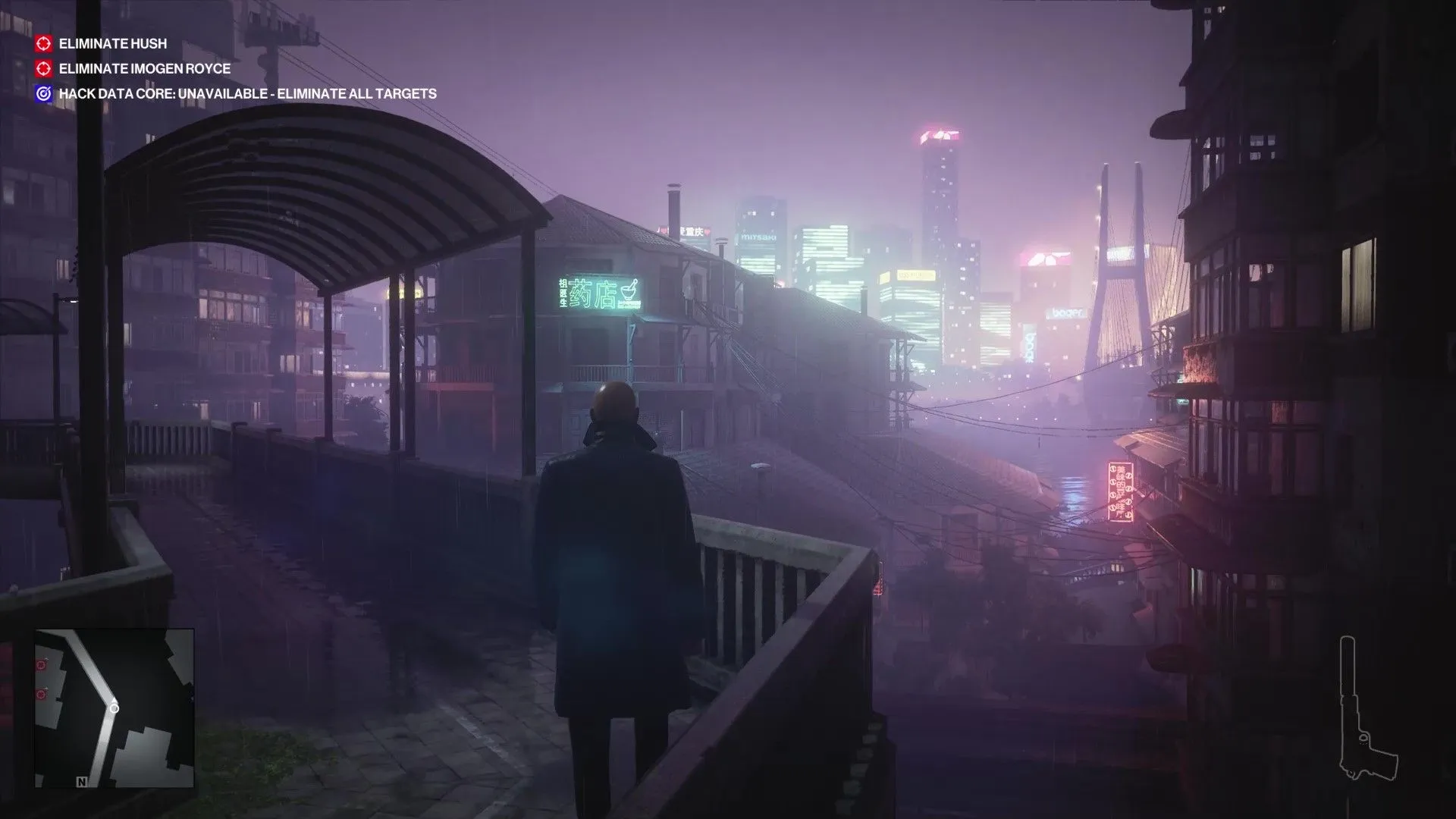
Hitman 3 by IO Interactive
I'll admit that I'm not sure how Hitman 3 does this. It's either authored by IO Interactive or there are some rules that govern camera movement that are not immediately obvious to me. It appears that the more distant view is when the area opens out more, but enclosing Agent 47 between cars and walls doesn't transition it to the over-the-shoulder view.
There is perhaps no better example of how flexible the third-person perspective is than Nier: Automata's opening sequence. Nier: Automata begins in a top-down shoot-em-up view. This transitions to a short third-person segment before pulling the camera back to transition into a side-scrolling view.
First to Cinematic
I remember games using the cut version of these a lot more years ago. To me, they remind of a different era of game development where cameras were less cinematic than today. Today, we like to be a bit more smooth.
In short, these cuts can jar. Once you start throwing cinematic cuts into a game, you become beholden to the rules of cinematography, like the 30-degree rule and the 180-degree rule. These cinematography don't need to be observed, they are more like guidelines after all, but understanding what's common in film helps lend that cinematic feel to a scene.
Case Studies
Here be Spoilers
Cyberpunk 2077
CD Projekt Red faced some pushback on the moving of Cyberpunk 2077 to a first-person perspective. Without weighing too heavily into that argument, I'd like to discuss what Cyberpunk – in my opinion – gained and lost from the change.
Personally, I'm a fan of third-person cameras. I find it easier to roleplay in that perspective than in first-person, and find myself more invested in the character. I find myself reverting to how I prefer to play in first-person than how my character would act.
Interestingly, this "reverting to type" is something Arkane identified in Prey 2 and other immersive sims in their GDC talk about Mooncrash. Suffice to say, Mooncrash has a pretty interesting solution to pushing players out of their comfort zone.
That note aside, The Witcher 3 and Cyberpunk 2077 are completely different games with very different lead characters, so I'll try to use them to contrast each other.
In Cyberpunk 2077, V is blank slate character that the player may step into, and this choice lines up well with the first-person choice. We, the player, are stepping into the shoes of V, the character. Our choices are V's choices, and here raises the first minor issue of the perspective. The range of dialogue options need to be wider for this type of character, because the players will differ greatly. I personally think there's a case to be made for this leading to more branches in the dialogue structure.
In the case of Geralt in The Witcher 3, he is a defined character from a series of books, complete with his own personality, vices, and relationships. We don't so much step into Geralts shoes in this game as walk beside him. And for this dynamic, the third-person perspective suits pretty well in my opinion. To contrast the above point of dialogue options with Geralt, The Witcher 3 need only supply variations of line that Geralt would actually say. To stray too far is to betray his character and risk breaking the players suspension of disbelief.
One standout takeaway I had from my time with Cyberpunk 2077 was the excellent atmosphere the game managed to achieve in the first act of its story. The story enjoying putting the player into an chain of events that escalate in the most action-movie way. Were this act the entirety of the story, it would be a contrived one-in-a-million type deal.
Luckily, it isn't. It's the inciting incident that kicks off the story proper. It's in core story moments that Cyberpunk best shows what the highly immediate first-person perspective does best: applies the series of unfortunate events directly to the player. We don't feel pity for the poor soul that's enduring it, no. We are that poor soul, and the game asks us, V, to seek a remedy to our predicament, and in true dystopian, cyberpunk fashion, such a remedy doesn't exist.
Spoiler: Act 1 Cyberpunk 2077
In particular, the scene where you hide in the pillar with Jackie in Yorinobu's apartment creates a sense of hopelessness and dread. It's something I doubt would be felt so viscerally were the perspective in third-person. It works because in that moment, you – the player – are in that situation, and that situation is claustrophobic.
Another takeaway I had while playing Cyberpunk 2077 was the connection to the major NPCs in the game. I cared about the storylines of those characters in a way that I didn't really about The Witcher 3's supporting cast. That's not to say I didn't care about The Witcher 3's characters, but I mostly cared about Geralt and Ciri, rather than Yennefer, Dandelion, or Triss, and maybe that's in part because the game focussed on the relationship of the two playable characters.
It's possible that I cared a bit more about the Cyberpunk cast as I didn't fully trust the game not to kill them if I was too slow. To me, that seemed very on-brand for the Cyberpunk universe. Whilst I don't believe that that is actually the case, I'd have liked to see it. That's not to say we don't get character deaths, but they avoid killing any of the deuteragonists.
Gears 5
This case study will be quite short. I'm not reviewing the game in full here, and some of Gears 5's standouts are not directly related to the choice in camera perspective.
Gears 5 uses a third-person over-the-shoulder perspective. While I haven't finished the game, what I've played so far has made ample use of highly polished cinematics to convey its story. These cinematics are often quite lengthy, and run the gamut of film techniques to portray the story.
One of the benefits of the third-person perspective is the ease with which cinematics can begin and end. A cutscene can seamlessly line the camera up behind the player then transfer the controls. This type of transition would likely jar in first-person unless handled with extreme care.
That said, Gears 5 can definitely draw you into their characters too, and unlike Cyberpunk...
Gears 5 Late Game Spoiler
... unlike Cyberpunk, Gears 5 is actually willing to kill a main, playable character. And better still? It's the player's choice which. The game almost breaks the fourth-wall to make clear that there is a choice to the player.
The last bit is quite important in giving the player agency in the situation.
The third-person camera in Gears 5 also allows the actions in the spoiler above to not reflect badly on the player character, Kait. She didn't know the consequences her actions would have had, but as players, we did. We made a meaningful choice.
Hitman 3
Hitman switches routinely between a distant third-person and a third-person over the shoulder perspective. In part, this allows for easier navigation of spaces as the camera should adapt to a variety of situations.
It's a good use of an adaptive camera, though Hitman 3's slower, more methodical pacing makes it nice-to-have rather than something more critical.
